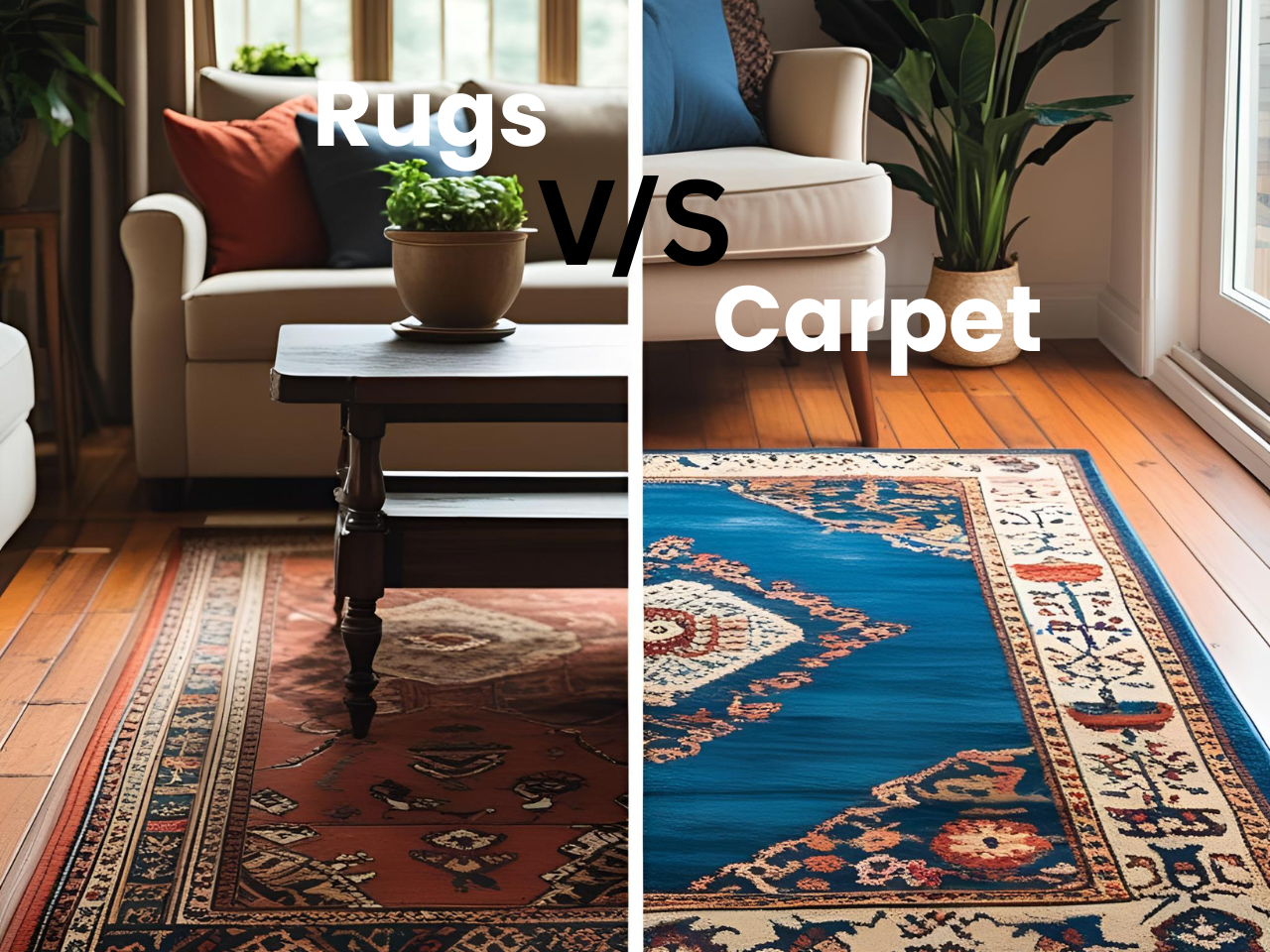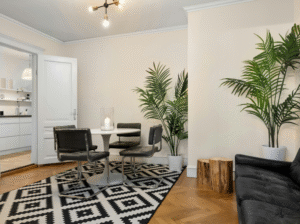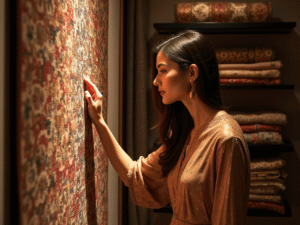When looking for flooring most people will are using “rug” and “carpet” as interchangeably. Both serve the primary function covering floors and adding beauty to the interior space the terms are distinct items with distinct features, functions and installation techniques. Understanding the distinction between carpet and rug will help you make better design choices, pick the best carpet for your space and also better communicate with designers and retailers.
The distinction goes beyond simple semantics. Each choice has distinct advantages to different living conditions budgets, designs, and objectives. If you’re decorating a brand new house, renovating one space as well as working with an interior stylist choosing the right rug or carpet can change the look of your home more effectively.
What Is a Rug?
Rugs are portable floor covering that normally is only used to cover a part of the floor area. Rugs are made to be easily moved, making them versatile tools for decorating that are easily moved and replaced or moved when you relocate your home.
Rugs are often used as accent pieces to define certain areas of a space. It is possible to place a rug under the table of your living space, next to the bed or even in the entranceway to create a warm focal feature. Rugs are available in a variety of designs, such as rectangular, round oval, runner designs, each one suited to various spaces and uses.
Rugs that are portable is why they are so popular with those who live in a rental, frequently move and those who love changing the decor of their homes seasonally. In contrast to permanent floor coverings carpets can be folded and stored away, then reused across different rooms or areas.
Key Characteristics of Rugs:
- Smaller in size
- The floor is not fixed
- Available in various shapes (round or rectangular and runners)
- It is easy to move, clean or replace
- Ideal for layering over carpets or floors.
What Is a Carpet?
Carpets are floor covering that is typically wall-to-wall or covers a large portion of the floor surface. Carpets are generally placed as semi-permanent or permanent fixtures, typically extending underneath furniture, and covering the whole floor.
Carpet installation typically requires professional fitting which is fixed to the floor with adhesives, tacks, or special installation techniques. Carpets that are permanent are part of the interior design instead of being decorative elements.
Carpets offer a wide cover and insulation, which makes them popular for living rooms, bedrooms as well as other rooms in which warmth and comfort are the top priorities. They’re designed to provide an unifying floor surface which serves as a neutral backdrop to furniture and décor.
Key Characteristics of Carpets:
- The larger size usually will cover the entire space
- Usually fixed or installed to the floor
- It provides full coverage and a seamless appearance
- Long-term and durable
- Typically, it is recommended to have a professional install and ongoing maintenance
Key Differences Between Rugs and Carpets
Understanding the fundamental differences between rugs and carpets helps clarify when to use each option:
| Feature | Rug | Carpet |
|---|---|---|
| Size | Smaller, portable | Larger, often wall-to-wall |
| Installation | No installation needed | Usually fixed/installed |
| Mobility | Easy to move | Stationary or permanent |
| Use Case | Accent, layering, highlights | Full-room coverage |
| Maintenance | Easier to clean or replace | More effort to clean/replace |
| Cost | Usually less expensive | Higher due to size & fitting |
Size and Coverage
Rugs are usually smaller and are designed to cover a specific area within a space, whereas carpets cover a large area of floors, usually covering entire surfaces. A typical living room rug could be 8×10 feet, while carpet will cover the entire area.
Installation Requirements
Carpets don’t require any need for installation, and they can also be put directly on flooring. Carpets usually require professional installation, which involves measurements, cutting and fixing the carpet to the floor surface.
Mobility and Flexibility
Carpets are completely portable and can be moved changed, or moved when required. Carpets are stationary structures that are not removed until they have been they are removed by a professional.
Maintenance and Cleaning
Rugs are able to be taken outside for cleaning, referred to a professional cleaning service, or even machine-washed based on the size and type of material. Carpets require cleaning in-place using equipment and techniques that are specialized.
Cost Considerations
Rugs are generally less expensive than carpets because of their smaller dimensions and absence of installation needs. Carpet prices include both the material and professional installation costs and installation costs, which means they are a greater initial investment.
Design Impact
Rugs are decorative pieces that be used to complement or even contrast with the flooring in place, while carpets are the primary floor that determines the overall aesthetic of the room.
Functional and Aesthetic Considerations
The choice between carpets and rugs is based on your individual requirements, preferences and design objectives. Rugs are ideal for situations that require the flexibility of a rug and are easy to maintain. They’re great for rental homes that don’t allow permanent changes and homes with children or pets where regular cleaning is required and spaces where you want to change the décor often.
Carpets are ideal when you’re looking for a comprehensive floor coverage as well as better insulation or a uniform look across an area. They are particularly useful in bedrooms where comfort for your feet is essential, as well as in formal living spaces where a sleek, long-lasting look is sought-after.
Many interior designers utilize the two options in a strategic manner, layering carpets with rugs to add visual depth and visual interest. This method allows the softness and coverage of carpet, while also creating color, pattern and texture with strategically placed rug designs.
Regional and Cultural Terminology
The words “rug” and “carpet” have different meanings across various cultures and regions. For instance, in Indian markets, which include traditional weaving centers such as Bhadohi these words are usually utilized based on the product’s intended purpose rather than its the size of the item. Carpets made of hand-woven flooring from these regions could be termed carpets, regardless of their dimensions, which reflects their skill and significance to the culture.
American usage generally follows the distinction of size Carpets tend to be more spacious and rugs having a smaller size. British English sometimes uses “carpet” more broadly, covering wall-to-wall installation as well as large areas rug.
Understanding regional differences can help in shopping, especially when you’re cooperating with retailers from other countries or looking into the hand-crafted products from weaving regions that have a long history.
Making the Right Choice for Your Space
Carpets and rugs both play crucial roles in interior design and the right choice will depend on your particular circumstances. Take into consideration your lifestyle and budget, your maintenance needs and style goals in making your choice.
Rugs are versatile and simple maintenance, which makes them ideal for living spaces that are dynamic and temporary solutions. Carpets offer a wide coverage and comfort that is perfect for long-term installation as well as formal areas.
Don’t forget that you don’t have to select just one choice. Many of the most successful interior designs use carpets and rugs, employing both in areas that offer the greatest benefits. This method of layering can result in lush, tactile spaces that can be both functional and attractive.
Frequently Asked Questions
Do I have to use an area rug over carpet?
In fact, layering rugs over carpets is a well-known method of interior design. This method adds visual interest creates seating areas and creates new patterns or colors. Select rugs with different thicknesses or textures to add depth and keep the look of layered rugs from looking flat.
Is it true that carpets are always costlier than rug?
Not necessarily. Although carpets generally cost more because of their size and requirements for installation Rugs made by hand aren’t cheap. The price will vary based on the materials used, the craftsmanship size, and the brand. A tiny high-end rug could be more expensive than standard wall-to-wall carpeting.
What’s a runners rug?
A run rug is a narrow rug, which is commonly used in entranceways, hallways or in conjunction with furniture. The standard runners are 2 feet wide and range from 6 to 14 feet long, which makes the perfect choice for marking pathways and bringing the feeling of comfort to spaces that are transitional.
Which one is the best for children or pets? Rugs or carpets?
Rugs are usually better suited for families with pets or children because of their ease of cleaning and repair capability. If you have an accident it is easy to immediately take and clean your rug or replace it completely should it be required. Carpets are a magnet for staining and odors that are difficult to remove.
Change the look of your space by Choosing the Right Floor Covering
Knowing the difference between carpets and rugs allows you to make informed choices that will enhance your home’s comfort as well as style and practicality. Whichever option you pick, whether it’s the pliableness of rugs or the vast covering of carpets, or mixture between both. The correct flooring can make your home more inviting and beautiful living space.
Are you ready to look into your possibilities? Explore our carefully selected collection of hand-crafted rugs which bring the traditional art of weaving and modern style to create contemporary spaces.





